WatchTime Wednesday: How Panerai Became a Manufacture

Panerai is now recognized as one of the major brands in the industry and has a huge impact on its aficionados and collectors, the ‘Paneristi’. But it has not always been like that. Back to its roots in the 1940s, Panerai was only a military oriented-workshop. But once the Richemont Group bought it in 1997, it became a real manufacture, with its own movements. And that’s the story that our friends from WatchTime tried to relate you.
When it comes to making movements, Officine Panerai is on the move. At the SIHH 2013 show in Geneva in January, Panerai introduced four new movements designed and produced in-house. The new P.2006 caliber is a manual-wind movement with an eight-day power reserve that beats inside the Luminor 1950 8 Days Rattrapante with a linear power-reserve indicator. Panerai also introduced a new family of movements, the P.9000 series, three automatic calibers equipped with a range of different functions. The movements are used in six new watches in Panerai’s Luminor 1950 collection.
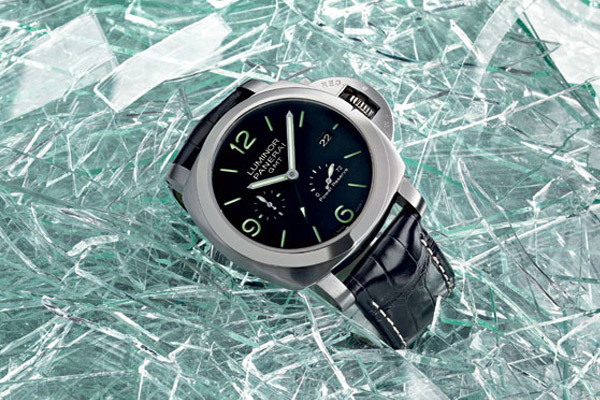
The addition of four new movements doubles the number of calibers that Panerai makes in-house. “This is an undertaking that Officine Panerai has completed in an incredibly short time,” says Panerai CEO Angelo Bonati. “The design of our first in-house caliber dates back to 2002. Few other watchmakers have succeeded in developing and making eight of its own calibers fully operational and available in just seven years.”
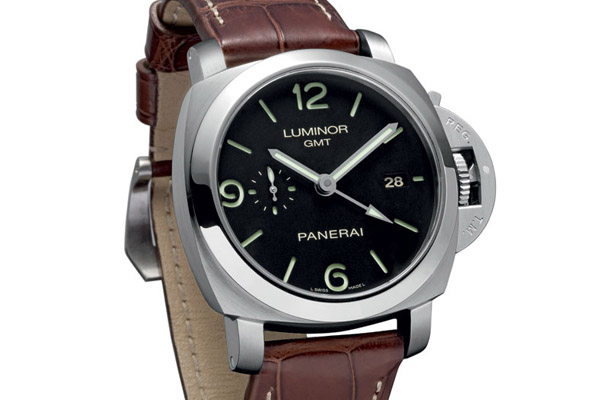
Bonati has reason to be proud. He was brought in to run Panerai just after the Richemont Group acquired the brand in 1997. With the financial support of Richemont Group’s executive chairman Johann Rupert, Bonati pursued a consistent product, marketing and sales policy for the brand. At the SIHH watch show in Geneva in 1998, he launched a collection of strikingly oversized black watches. He was greeted with pitying smiles and questions such as “Who needs something like that?” But just one year later, the critical chorus had fallen silent. Panerai’s small production was in great demand. Retailers were climbing over one another to get their hands on the few Panerai watches available. Bonati and his team masterfully played hard to get, piquing would-be purchasers’ interest by deliberately keeping production numbers low. One result of this limited-edition strategy was that the 1997 models soon acquired significantly greater value, unusual for a relatively new watch brand.
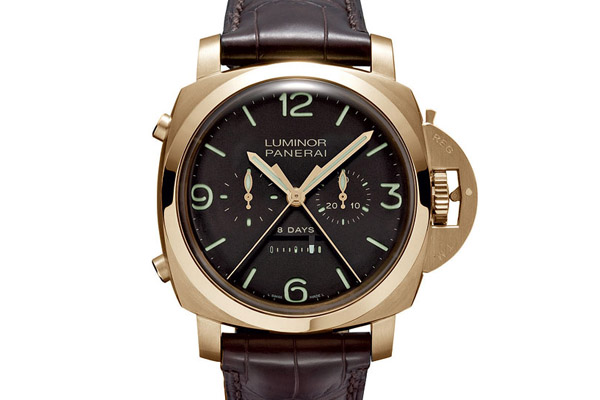
Much has been written about Panerai’s history (the Florence-based firm was a supplier of instruments to the Italian Navy and began making divers’ watches for a special commando unit in 1936) and its post-acquisition revival into a cult watch with a devoted fan base of “Paneristi.” Less attention has been paid to the role of movements in the brand’s success. The movement strategy was developed by Bonati and Eric Klein, technical director of Manufacture Horlogère Valfleurier, the movement-development subsidiary of the Richemont Group. Working together closely over the past seven years, they have orchestrated Panerai’s surprising leap into the ranks of leading players in the Swiss mechanical-watch league.
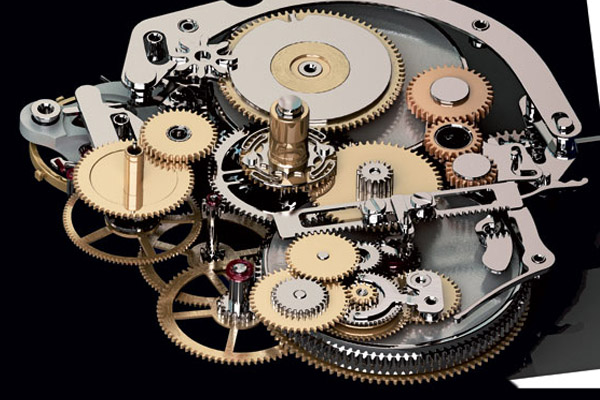
In the post-1997 period, Panerai got most of its movements from ETA, Switzerland’s largest watch-movement manufacturer. The ETA movements were supplemented by calibers from Frédéric Piguet, Zenith, Jaquet (now La Joux-Perret) and Soprod. A review of the movements that Panerai has used since 1997 reveals a number of horological highlights. This portfolio of excellent calibers contributed to Panerai’s speedy success since then.
The ambitious post-1997 period is distinguished by “normal” wristwatches that continued the legacy of the firm’s original two models, Radiomir and Luminor. Most of these watches carried either a Unitas 6497 or a Valjoux 7750 that had been modified especially for Panerai. Stripped of its chronograph mechanism, this reliable workhorse caliber bears the designation “OP III” and supports a small seconds subdial at 9 o’clock. It is still used in some of Panerai’s current references.
In addition, Panerai launched each year interesting special series that garnered a lot of attention. Many of these watches are equipped with rare calibers that are almost impossible to come by nowadays. These pieces in particular testify to the inventiveness of the brand. In the years prior to 2008, Panerai introduced more than 60 limited-edition models.

In 2001, however, Bonati had the idea of equipping some of his watches with calibers of his own. The developmental process began in 2002. In 2005, Richemont bought a small factory to produce these calibers and Panerai joined the ranks of manufacture brands (defined as a firm that has developed and produced at least one of its movements entirely in-house).
Panerai’s first in-house movement was the P.2002, with 245 components. This caliber has the same diameter as the OP III: 13¾ lignes, or 31 millimeters. Its height is 6.5 millimeters. Three serially switched barrels ensure eight days of power, indicated by a linear power-reserve display on the dial. The well-balanced management of this reserve of energy allows the balance (with a moment of inertia of 7 mg.cm2), regulated by a freely oscillating balance spring, to tirelessly sweep through at least 200° of amplitude at a frequency of four hertz. To facilitate to-the-second time-setting, the balance can be stopped manually, which causes the hand on the seconds subdial at 9 o’clock to return to its vertical position. An auxiliary hour hand can be reset in one-hour increments by turning the crown after it has been pulled out halfway. The date display in the window at 3 o’clock corresponds to the local time.
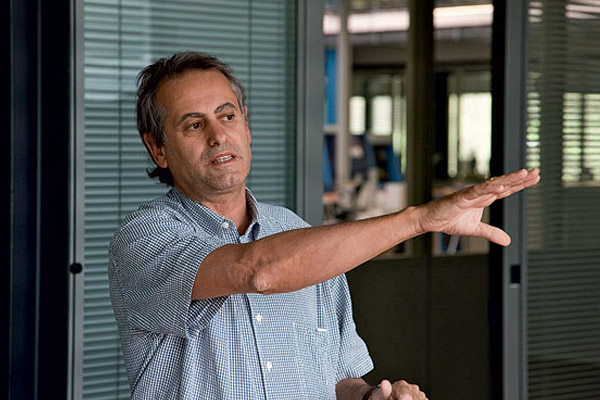
Panerai followed a similar path in the subsequent calibers P.2003, P.2004 and P.2005. According to Klein, 60 percent of the components are identical in all Panerai calibers. This helps prevent prices from skyrocketing, despite the relatively small quantities manufactured each year.
The P.2003 caliber, which has 301 components, is the self-winding version of the P.2002. Its centrally positioned swinging weight and its self-winding mechanism increase the movement’s height to 8.2 millimeters. Zircon balls for the rotor’s bearing minimize the need for maintenance. Klein explains that the large size of the movement and its rotor prompted Panerai to opt for a bidirectional self-winding mechanism: “Our experience with the similarly large ETA-Valjoux 7750 showed us that the rotor moves at a very fast speed when it swings in its no-load direction. This velocity causes undesirable noises and a queer sensation on the wrist, and it isn’t very healthy for the gear train, either. Our self-winding mechanism ensures uniform, well-balanced motions of the rotor in both directions.” Klein takes a different view of smaller self-winding calibers, in which a swinging weight can wind the mainspring in only one direction without any unwanted side-effects. The P.2002 severs connection with the remaining power in the mainspring after eight days, but this safety precaution isn’t necessary on the P.2003, which can run uninterrupted for 10 days.

Caliber P.2004 is a hand-wound chronograph with eight days of autonomous running and a column wheel to control its chronograph functions. This 8.2-mm caliber has 333 parts. Panerai uses a vertical coupling mechanism, i.e., a force-locking connection with two disks. One push-piece at 8 o’clock is responsible for the three chronograph functions (start, stop and return to zero). An innovative return-to-zero lever with sprung ends helps to reduce pressure on the bearings of the chronograph’s elapsed-seconds hand and on the bearings of the elapsed-minutes hand, which tallies intervals up to 30 minutes.
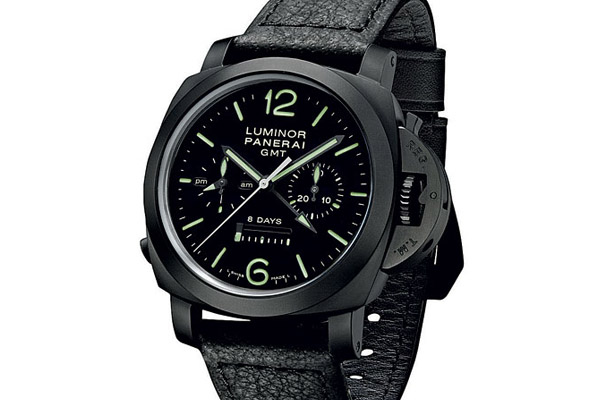
The fourth musketeer appeared in 2007, the hand-wound Caliber P.2005, which contains a very unconventional tourbillon and GMT function. The caliber does not contain a conventional rotating tourbillon cage to compensate for the effects of gravity when the watch is in a vertical orientation. Instead, Klein has come up with a cage that rotates on an axis parallel to the base of the movement at right angles to the axis of oscillation of the balance. What’s more, the cage makes two revolutions per minute, as opposed to the one per minute of most other tourbillons, so friction is minimized in the bearings of the balance arbor, pallet lever and escape wheel. Klein calls his construction “a chicken on a rotisserie.” It is made possible by the comparatively small diameter of the balance and by the movement’s stately height of 9.1 millimeters. However, the rotisserie arrangement increases the diameter of the movement to a hefty 16½ lignes or 36.6 millimeters, like that of the current Unitas-based hand-wound Calibers OP X and XI. Propelling the series of gear trains saps plenty of energy, reducing the power reserve to six days, despite the presence of three barrels.
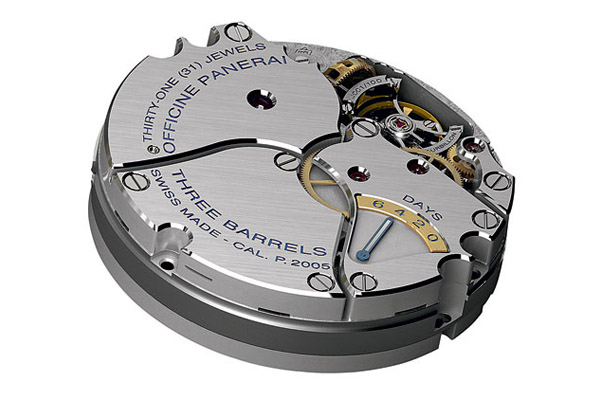
Panerai’s design is better at compensating for errors caused by changes in position, which are more numerous in a wristwatch than the pocket watches for which the tourbillon was originally invented. Klein is understandably proud: “My tourbillon ranks among the best inventions in mechanical timekeeping. And it can be produced without major problems thanks to our ultramodern facility at Valfleurier.” But like all good things, making it takes plenty of precious time: aficionados who want to own a wristwatch containing Caliber P.2005 must be patient, as the waiting period can be several years.

To these four movements, Panerai has this year added four more. The new P.2006 caliber introduced in January is the latest and most sophisticated version of the P.2004. It is a hand-wound, split-seconds chronograph movement with double column wheel that, in addition to the push-piece at 8 o’clock to regulate the start/stop/reset functions, has another push-piece at 10 o’clock to start the split-second function. The movement has 356 components, three barrels providing eight days of power, and a frequency of 28,800 vph. It is used in the new Luminor 8 Days Rattrapante watch with a 47-mm-diameter rose-gold case, two counters, and a linear power-reserve indicator.
The new P.9000 family consists of three automatic calibers (P.9000, 9001 and 9002). All have a diameter of 13¾ lignes, two barrels that guarantee 72 hours of power reserve; a single-piece rotor, which winds in both directions thanks to an ingenious ratchet device; a balance wheel with adjustment screws, oscillating at a frequency of 4 Hertz; and a date display and stop-seconds device that allows for accurate synchronization of the hand with an external time signal.
The P.9000 caliber has 195 components and is 7.9 mm thick. It is used in the new 44-mm, steel-cased Luminor 1950 Marina watches (PAM 312 and 328) and the 47-mm, titanium-cased Luminor Submersible (PAM 305).
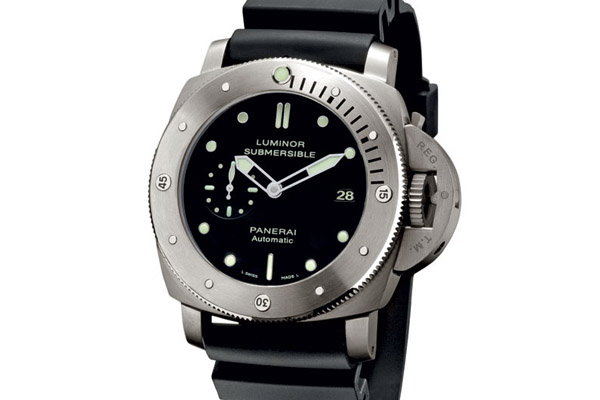
The P.9001 caliber, with 227 components, is equipped with a GMT function, a seconds-reset device, and a power-reserve indicator, shown on the back of the watch. It powers two 44-mm, steel-cased Luminor 1950 models (PAM 320 and 329).
Caliber P.9002, with 236 components, also has a GMT function. It differs from P.9001 only in the positioning of the power-reserve display. P.2002 powers the Luminor 1950 GMT Power Reserve, which uses a small hand in a circular arc on the dial to indicate the power reserve.
All of the watches containing P.9000 caliber movements belong to Panerai’s Manifattura Collection of watches containing in-house movements. Sharp-eyed Paneristi will notice that for these six new models, Panerai slightly altered the design of the Luminor 1950 case. It keeps the proportions of the original, but holds a slightly less convex sapphire crystal, which barely protrudes above the bezel.
A tour of Panerai’s three production sites begins at the Panerai manufacture in Neuchâtel, which commands a lovely view of the lake. The building formerly housed the Swiss watch brand Bertolucci. Prior to that, it served as Neuchâtel’s police station. Heading up operations here is Jean-Robert Martinet, a 41-year-old mechanical engineer. He directs about 100 people; about one-quarter of them have undergone a complete watchmaker’s apprenticeship. His team takes care of everything needed to produce a complete watch. They check the precision of arriving merchandise and scrutinize the kits for movements delivered by Valfleurier. The number of components that they keep track of totals more than one million a year. To avoid wasteful downtime, everything must be where it needs to be at exactly the right moment. The team’s most important tasks are the assembly and fine adjustment of watch movements, as well as equipping them with dials and hands. Monitors above the workstations display in detail whatever task needs to be done. Lubrication occurs completely automatically, ensuring that only a measured amount of each lubricant is applied. Casing takes place under near-clean-room conditions. The final step is a scrupulous quality control of the finished product.
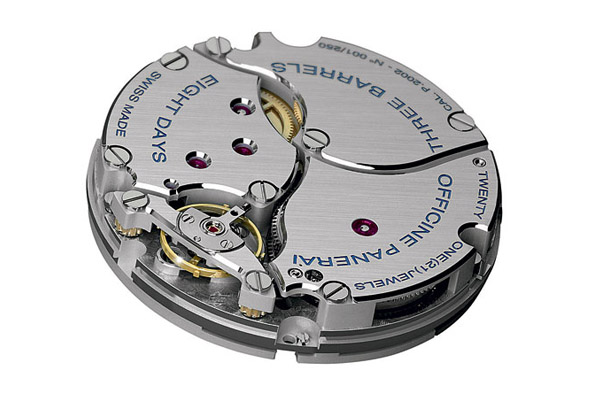
A research and experimental laboratory is also on the premises. The building is already bursting at its seams, so Panerai operates a second site, also in Neuchâtel. The strained situation should improve in 2010, with the opening of a new 16,000-square-meter building. The brand’s origins and corporate identity as maker of divers’ watches will be underscored by a huge basin of water, into which a passenger elevator will descend.
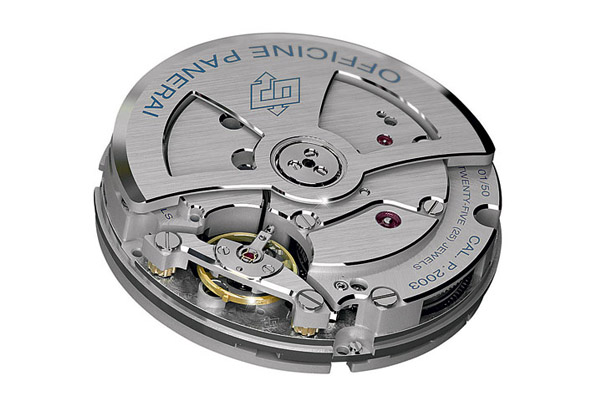
Panerai’s technical partner, Manufacture Horlogère Valfleurier, is housed at two separate sites. Some 30 workers doing research and development are housed in Neuchâtel in Richemont’s former administrative building. Visitors are not particularly welcome here because the work is almost as secret as when Panerai took orders from the Italian Navy.
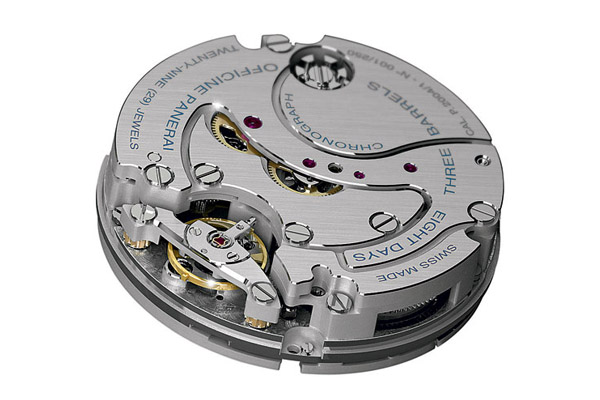
Things are much less confidential at the rapidly growing complex of buildings in the small town of Buttes, located in the Fleurier Valley (hence the name Valfleurier), about a 30-minute drive from Neuchâtel up into the Jura Mountains. Richemont bought a small factory in Buttes in 2005 to produce Panerai calibers. When the factory quickly expanded and ran out of space, Johann Rupert gave the green light to construct new buildings. The staff in Buttes has grown from the original 30 to 255. (All in all, the Valfleurier firm employs 355 workers.) Richemont has invested heavily in Buttes, where computer-guided, fully automated, manufacturing machines stand side by side in the new halls. Some 60 of them are already in operation here. For tasks requiring human hands, the staff works in two shifts. The automated machines have four axes and can work around the clock, if need be, without any problem. Valfleurier produces more than a million components per year.
Certain highly complex components for the tourbillon Caliber P.2005 require machines with 10 different axes. The most demanding component is the column wheel for chronographs. The machines that manufacture these pieces have 11 axes.
Coming soon is a brand-new assembly line for Panerai. At a price of two million Swiss francs, it is believed to be the costliest of its kind. Its development and installation will take 18 months. “Seven of its 25 positions work automatically; human beings will man the other 18,” Klein says. “It will be as flexible as a modern assembly line in the automobile industry.”
The original article was published on watchtime.com and is republished here with permission.




1 response
Hi, I miss the story about sylvester Stallone